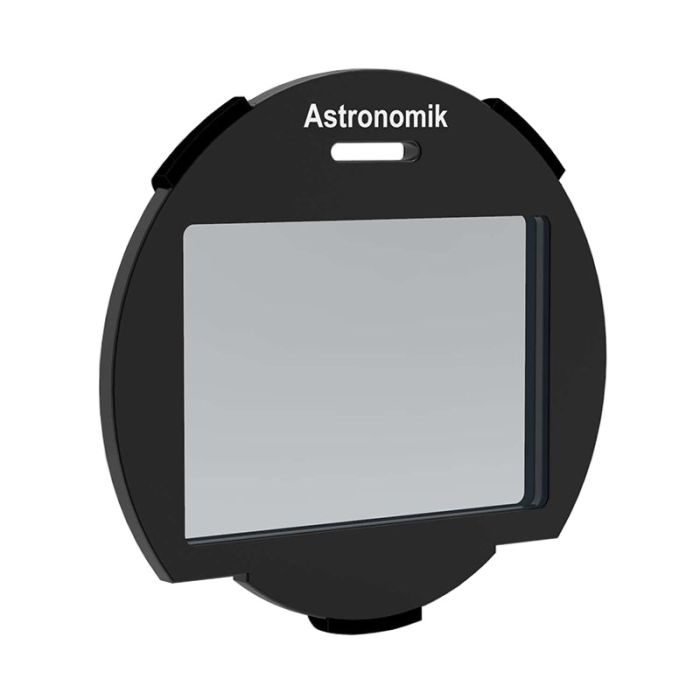Astronomik L-2 UV-IR Blocking Filter - Canon EOS R XL Clip
Astronomik UV-IR Blocking Luminance Filters
In order to produce an exceptional final image, the Luminance channel is probably the most crucial. The filter should feature the highest possible transmission with a wide spectral bandpass so you get as much signal as is viable. This combination enables impressive sensitivity and provides you with the greatest pixel photon counts. While the high transmission level is an excellent feature of Astronomik's new Luminance filters, not all optical instruments, or supplemental optical devices such as correctors, field flatteners, or reducers, enjoy perfect color correction. Thus the Luminance filter's spectral bandpass width can be an issue. A band pass with too much width enables the transmission of light that is not completely focused (chromatic aberration), making stars display as soft or bloated. In such instances image processing can be challenging. Therefore, having a marginally narrower spectral window in your Luminance filter can lessen or even do away with this detrimental effect altogether.
Astronomik has updated their Luminance filter line to include three different spectral window widths so that you can match your L filter to the type of telescope you use. The "L-2" filter is very similar to the classic Astronomik Luminance filter. By contrast, the L-1 has a wider spectral window, while the L-3's spectral window is narrower.
Your telescope's color correction will determine whether you should use a filter with a wider spectral window for the Luminance channel. The L1 features the widest spectral window, while the L3 has the narrowest. The L2 is roughly the same as the current Astronomik L-Filter.
If your optical system is completely chromatic aberration free, you should get an L1 filter for your setup. For general use with most optical systems employing a corrector, flattener or reducer in the optical train, the L2 is optimal. The L3 filter is made for users with refractors that have less than ideal color correction. Plus, when used in conjunction with Astronomik's new Deep-Sky RGB filters, the L3 filter will reduce that annoying bluish halo around stars.
The transmission curve characteristics and coatings on the new Luminance filters have been designed and engineered in such a way that no halos or reflections will be visible. Even with bright stars in the field of view you will be able to reveal the faintest structures in galaxies or nebulae.
Like all Astronomik Filters, the new Luminance filters are made using an extremely durable and scratch resistant coating, deposited on the finest polished optical substrate, which is free of any striae or internal strains. All substrates are made to exactly the same thickness, so all Astronomik filters are parfocal.
Astronomik UV-IR Blocking Luminance Filter Highlights
- This EOS R XL clip formatted L-1 UV-IR Blocking Filter from Astronomik is compatible with Canon EOS R and RP full frame mirrorless camera models
- For the best possible sharpness, contrast, and low noise of luminance data critical to obtaining high quality imaging results, use this Astronomik UV-IR blocking filter
- No housing modifications are needed to use this filter
- Insertion requires only a finger while removal is done with the aid of an included small hook
- Parfocal with every other filter made by Astronomik
- Multi-layer coatings provide complete resistance to the impacts of scratching, aging, and high humidity
- Diffraction limited, this filter will not compromise your telescope's optical performance
- Astronomik filters arrive with a long-lasting plastic filter case of supreme quality
- Made in Germany, a country renowned for producing superior optics
Astronomik EOS R/RP Clip Filter System
Designed for mirrorless full frame Canon EOS R and RP cameras for use in both metropolitan and suburban viewing areas, Astronomik EOS R XL clip filters do not require any camera modifications in order to be used.
Installation may be performed without tools using only ones finger while a small hook is included for initial help with filter removal. As soon as the filter is out far enough to grasp, you can use your fingers to take it out and place it back in its case. Imaging can begin once this filter is rested flush into place and the camera lens has been reinstalled.
Compatible Canon EOS Bodies
- EOS R
- EOS R5
- EOS R6
- EOS RP
- EOS Ra


